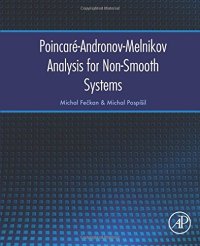
Ebook: Poincaré-Andronov-Melnikov Analysis for Non-Smooth Systems
Author: Michal Fečkan Michal Pospíšil
- Year: 2016
- Publisher: Academic Press
- Edition: 1
- Language: English
- pdf
Poincaré-Andronov-Melnikov Analysis for Non-Smooth Systems is devoted to the study of bifurcations of periodic solutions for general n-dimensional discontinuous systems. The authors study these systems under assumptions of transversal intersections with discontinuity-switching boundaries. Furthermore, bifurcations of periodic sliding solutions are studied from sliding periodic solutions of unperturbed discontinuous equations, and bifurcations of forced periodic solutions are also investigated for impact systems from single periodic solutions of unperturbed impact equations. In addition, the book presents studies for weakly coupled discontinuous systems, and also the local asymptotic properties of derived perturbed periodic solutions.
The relationship between non-smooth systems and their continuous approximations is investigated as well. Examples of 2-, 3- and 4-dimensional discontinuous ordinary differential equations and impact systems are given to illustrate the theoretical results. The authors use so-called discontinuous Poincaré mapping which maps a point to its position after one period of the periodic solution. This approach is rather technical, but it does produce results for general dimensions of spatial variables and parameters as well as the asymptotical results such as stability, instability, and hyperbolicity.
- Extends Melnikov analysis of the classic Poincaré and Andronov staples, pointing to a general theory for freedom in dimensions of spatial variables and parameters as well as asymptotical results such as stability, instability, and hyperbolicity
- Presents a toolbox of critical theoretical techniques for many practical examples and models, including non-smooth dynamical systems
- Provides realistic models based on unsolved discontinuous problems from the literature and describes how Poincaré-Andronov-Melnikov analysis can be used to solve them
- Investigates the relationship between non-smooth systems and their continuous approximations